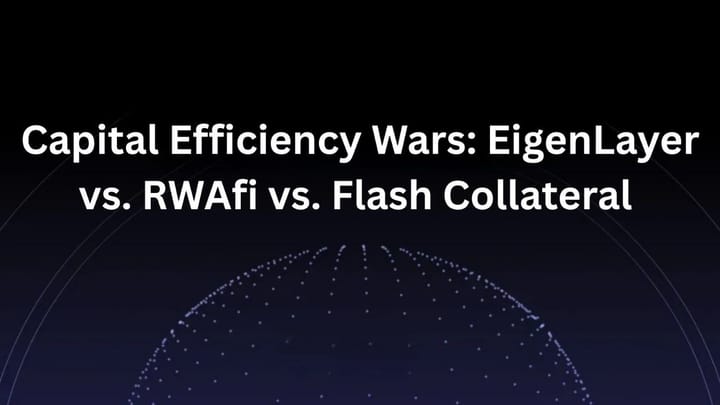Mitosis' Place in Modular DeFi's Trajectory: A Fit with Modular Blockchain Evolution?

Decentralized Finance (DeFi) has long struggled with fragmentation across multiple blockchains, forcing users to rely on inefficient bridges and liquidity pools. The ideal DeFi ecosystem should enable seamless liquidity movement, unlocking its full potential for composability and efficiency.
Modular blockchain solutions are emerging to address these inefficiencies, with projects like Celestia, EigenLayer, and various rollups revolutionizing how blockchains scale and interact. However, with these advancements comes a major challenge: liquidity fragmentation.
For modular blockchains to reach their full potential, liquidity must be as flexible, dynamic, and interconnected as the networks themselves. This article explores:
- Mitosis' Approach to Ensuring Security, Flexibility, and Cross-Chain Compatibility"
- How Mitosis Tackles Liquidity Fragmentation in This Evolving Landscape
- The importance of programmable and ecosystem-owned liquidity.
- The Emergence of Modular Blockchains and Their Significance
Understanding Mitosis: A Modular Liquidity Protocol
Mitosis is a modular liquidity protocol designed to solve liquidity fragmentation through programmable liquidity, ecosystem-owned liquidity (EOL), and cross-chain compatibility. As modular blockchains separate execution, consensus, and data availability, Mitosis ensures that liquidity remains fluid and efficient across all layers.
Understanding Modular Blockchains

Standard blockchains, exemplified by Ethereum and Solana, operate monolithically. This means they conduct execution, achieve consensus, and ensure data is available, all within a single, integrated chain. Although this architecture contributes to robust security and decentralization, it can restrict both scalability and adaptability.
Modular blockchains, conversely, decompose these tasks into separate layers. This design offers benefits in terms of specialization, increased efficiency, and expanded scalability. They are constructed from modular, interdependent elements, each dedicated to a particular function.
Key developments fueling this evolution include:
Rollups (Optimistic & ZK-Rollups) – Scaling methodologies which shift execution off the main chain, while continuing to utilize the security provided by Ethereum.
EigenLayer – An innovative restaking approach, enhancing security across numerous networks.
Celestia – Functioning as a data availability layer, allowing rollups to scale in isolation.
This modular framework facilitates specialization across networks. However, it also contributes to liquidity fragmentation, a challenge Mitosis is engineered to address.
Solving Liquidity Fragmentation with Mitosis

As blockchain ecosystems expand, liquidity fragmentation has become a major challenge. Assets are scattered across multiple chains, making it inefficient for users to trade, stake, or lend seamlessly across different networks.
Mitosis tackles this issue through three key innovations:
- Enabling Seamless Cross-Chain Compatibility
Rather than relying on traditional bridges—often susceptible to hacks—Mitosis acts as a decentralized value exchange layer, ensuring assets remain interoperable and liquid across multiple blockchains.
- Ecosystem-Owned Liquidity (EOL)
Traditional liquidity models rely on incentives that can dry up, leading to liquidity crises. Mitosis provides a sustainable alternative:
- LPs maintain greater control over asset allocation.
- Liquidity is managed under decentralized governance.
- This model fosters long-term stability over short-term incentives.
- Unlocking Programmable Liquidity
Mitosis introduces programmable liquidity by tokenizing liquidity positions into derivative assets. This allows liquidity providers (LPs) to:
- Improve capital efficiency by unlocking previously idle liquidity.
- Seamlessly move liquidity across different chains.
- Utilize liquidity tokens within DeFi applications for yield generation.
Security, Flexibility, and Cross-Chain Compatibility
DeFi users prioritize security, flexibility, and interoperability. Mitosis delivers these benefits in the following ways:
Cross-Chain Compatibility:
- Consolidates liquidity across ecosystems, reducing inefficiencies and slippage.
- Offers compatibility with both EVM and non-EVM blockchains, thus providing broad network support.
- Leverages cross-chain communication methods and smart contract automation to enable seamless interoperability among environments such as Ethereum, Cosmos, and Polkadot.
Flexibility:
- Enables dynamic rebalancing and targeted incentives for optimal liquidity management.
- Facilitates deep liquidity pools that support seamless asset movement between chains.
- Adapts to various DeFi applications, from AMMs to lending protocols.
Security:
- Reduces reliance on centralized intermediaries, ensuring verifiable and secure liquidity flows.
- Implements multi-party computation (MPC) and cryptographic techniques to prevent exploits.
- Provides a more secure alternative to traditional bridges, which are frequent targets for attacks.

While modular blockchains represent the upcoming trend in scalability and interoperability, the fragmentation of liquidity poses a significant hurdle. Mitosis steps forward as a core infrastructural component, facilitating programmable liquidity that functions across various chains and is managed by the ecosystem itself.
The evolving DeFi landscape demands the capacity to seamlessly, securely, and flexibly transfer assets across disparate networks. Mitosis goes beyond the conventional definition of a liquidity protocol; it signifies the dawn of the upcoming iteration of decentralized finance.


Comments ()